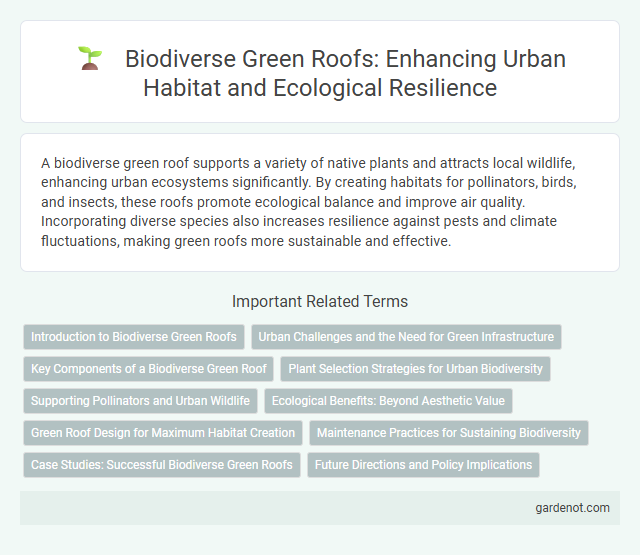A biodiverse green roof supports a variety of native plants and attracts local wildlife, enhancing urban ecosystems significantly. By creating habitats for pollinators, birds, and insects, these roofs promote ecological balance and improve air quality. Incorporating diverse species also increases resilience against pests and climate fluctuations, making green roofs more sustainable and effective.
Introduction to Biodiverse Green Roofs
Biodiverse green roofs create habitats for a variety of plant species, insects, and birds, enhancing urban ecological networks. These roofs utilize native and drought-resistant plants to promote ecosystem health and improve air quality. Integrating biodiverse green roofs in urban planning supports climate resilience by reducing heat islands and managing stormwater naturally.
Urban Challenges and the Need for Green Infrastructure
Biodiverse roofs address critical urban challenges such as air pollution, urban heat islands, and habitat loss by providing essential green infrastructure in densely built environments. These green roofs enhance urban biodiversity by creating habitats for pollinators and bird species, contributing to ecosystem resilience. Integrating biodiverse roofs into city planning improves stormwater management and reduces energy consumption, supporting sustainable urban development goals.
Key Components of a Biodiverse Green Roof
Key components of a biodiverse green roof include a diverse selection of native plants that support local wildlife and promote ecological balance. A well-structured substrate layer provides proper drainage and nutrient retention, essential for diverse vegetation growth. Incorporating habitat features such as rock piles or shallow water areas encourages pollinators and small fauna, enhancing the roof's ecological value.
Plant Selection Strategies for Urban Biodiversity
Selecting native and drought-tolerant plant species enhances urban biodiversity by providing habitat and food sources for local pollinators and birds. Incorporating a mix of ground covers, shrubs, and flowering plants creates layered ecosystems that support diverse wildlife populations. Prioritizing plants with staggered blooming periods ensures continuous nectar availability, boosting pollinator activity throughout the growing season.
Supporting Pollinators and Urban Wildlife
Biodiverse green roofs create essential habitats for pollinators such as bees, butterflies, and hummingbirds, enhancing urban ecosystems by supporting their reproductive cycles and food sources. Incorporating native flowering plants on green roofs boosts nectar and pollen availability, which contributes to increased pollinator activity and biodiversity in city environments. These roofs also offer refuge for urban wildlife, promoting ecological connectivity and resilience within densely built areas.
Ecological Benefits: Beyond Aesthetic Value
Biodiverse green roofs enhance urban ecosystems by providing habitats for pollinators, birds, and beneficial insects, which supports local biodiversity and promotes natural pest control. These roofs improve air quality by filtering pollutants and mitigating urban heat island effects, leading to cooler microclimates in densely built environments. Furthermore, they contribute to stormwater management by increasing water retention and reducing runoff, thus decreasing the burden on municipal drainage systems.
Green Roof Design for Maximum Habitat Creation
Biodiverse green roofs incorporate a variety of native plant species to create complex habitats that support pollinators, birds, and beneficial insects. Tailoring substrate depth and texture enhances microhabitats, promoting species richness and ecological resilience. Strategic layering and structural diversity in green roof design maximize ecosystem services while fostering urban biodiversity.
Maintenance Practices for Sustaining Biodiversity
Effective maintenance practices for biodiverse green roofs include regular monitoring of plant health, invasive species management, and adaptive irrigation techniques tailored to native flora needs. Incorporating seasonal inspections ensures early detection of pest infestations and nutrient deficiencies, promoting ecological balance and habitat stability. Utilizing organic fertilization and minimal disturbance methods supports sustainable biodiversity while enhancing soil quality and microhabitats.
Case Studies: Successful Biodiverse Green Roofs
Biodiverse green roofs, such as the Chicago City Hall and the Singapore's Gardens by the Bay, demonstrate significant ecological benefits by supporting native flora and fauna, enhancing urban biodiversity, and improving air quality. Case studies reveal that these green roofs reduce urban heat island effects by up to 5degC and increase rainwater retention by 40%, contributing to sustainable urban water management. Research from the University of British Columbia highlights how biodiverse roofs can boost pollinator populations by 35%, proving their critical role in urban ecosystem resilience.
Future Directions and Policy Implications
Biodiverse roofs enhance urban ecosystems by supporting native flora and fauna, which can mitigate climate change effects and improve air quality. Future directions emphasize integrating advanced monitoring technologies and adaptive design to optimize ecosystem services and resilience. Policy implications include incentivizing biodiversity metrics in building codes and promoting interdisciplinary collaboration to ensure sustainable urban development.
Biodiverse roof Infographic

 gardenot.com
gardenot.com